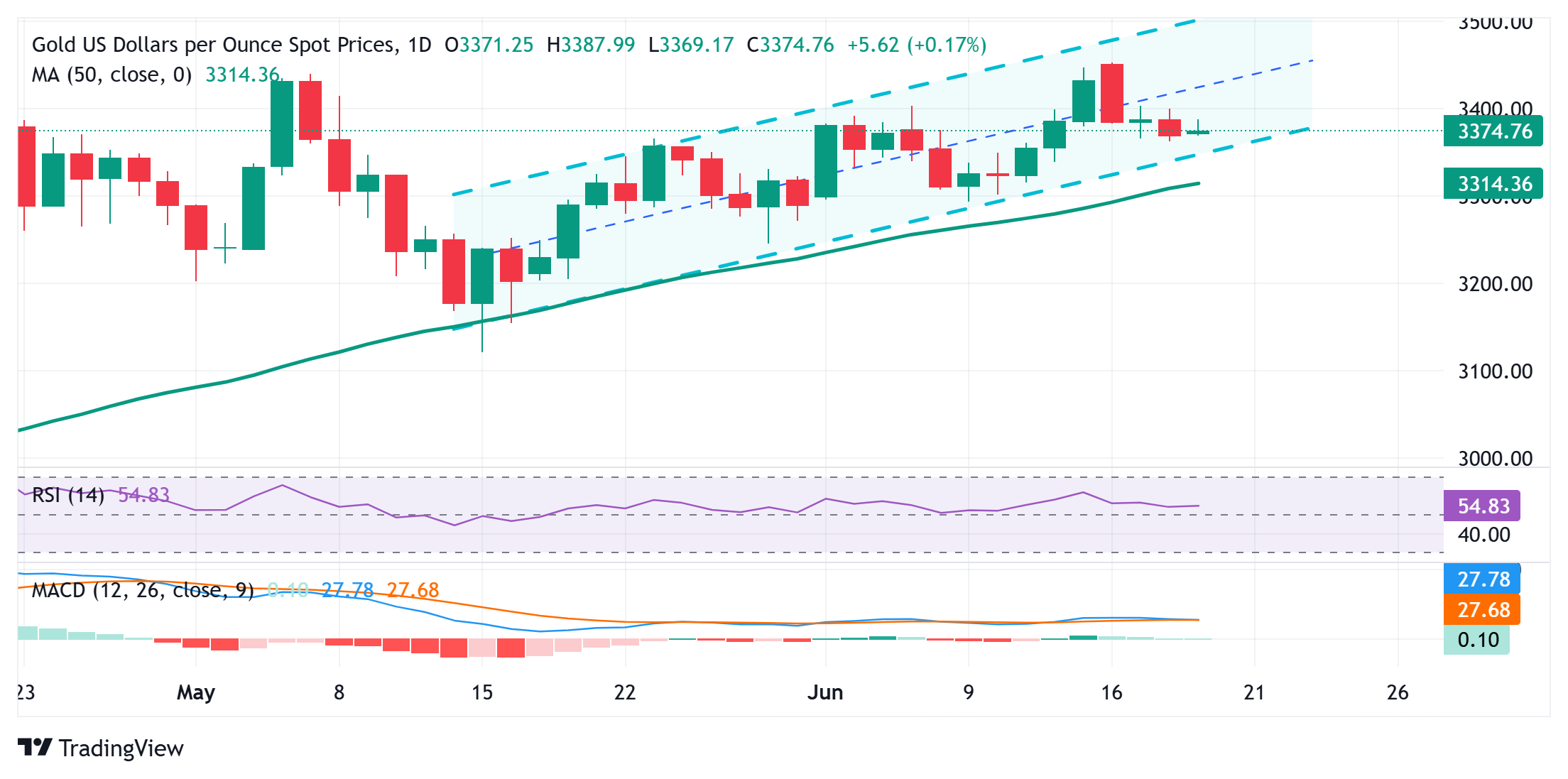- Gold price edges higher during the Asian session, though it lacks follow-through buying.
- Trade uncertainties and rising geopolitical risks underpin the safe-haven precious metal.
- The Fed’s hawkish pause lifts the USD to over a one-week high and caps the XAU/USD.
Gold price (XAU/USD) attracts some dip-buying during the Asian session on Thursday and recovers a part of the previous day’s losses to the $3,363-3,362 area, or the weekly trough. The global risk sentiment remains fragile on the back of persistent trade-related uncertainties and rising geopolitical tensions in the Middle East. This, in turn, is seen as a key factor acting as a tailwind for the safe-haven bullion.
Meanwhile, the US Federal Reserve (Fed) held interest rates steady at the end of a two-day meeting on Wednesday and signaled a slower pace of cuts in the future amid concern that US President Donald Trump’s tariffs could push up consumer prices. The hawkish outlook lifts the US Dollar (USD) to over a one-week high and keeps the non-yielding Gold price below the $3,400 mark, warranting caution for bulls.
Daily Digest Market Movers: Gold price struggles to lure buyers amid mixed fundamental cues
- US President Donald Trump held a Situation Room meeting Wednesday afternoon to discuss options in the Israel-Iran conflict. Media reports suggest that Trump has approved attack plans, though he wants to make sure that such an attack on Iran is really needed and that it wouldn’t drag the US into a prolonged war in the Middle East.
- As the Israel-Iran conflict enters its seventh day, the Israel Defense Forces (IDF) warned residents of the cities of Arak and Khondab in central Iran to evacuate for their safety as it is operating in the area against Iranian military infrastructure. This raises the risk of an all-out war in the Middle East and weighs on investors’ sentiment.
- Meanwhile, Trump earlier this week said that tariffs on the pharma sector are coming soon. This adds a layer of uncertainty in the markets ahead of the July 9 deadline for higher reciprocal US tariffs and lends some support to the safe-haven Gold price, though some follow-through US Dollar buying keeps a lid on any meaningful appreciation.
- The Federal Reserve, as was widely expected, kept interest rates steady amid concern that the Trump administration’s tariffs could push up consumer prices. In the so-called dot plot, the committee projected two rate cuts by the end of 2025, though policymakers forecasted only one 25-basis points rate cut in each of 2026 and 2027.
- Furthermore, seven of the 19 policymakers indicated they wanted no cuts this year, up from four in March, amid the risk that inflation could stay persistently higher and end the year at 3%. This, in turn, assists the USD to build on this week’s recovery from a three-year low and caps the upside for the non-yielding yellow metal.
- US banks will be closed on Thursday in observance of Juneteenth National Independence Day, which suggests relatively lower liquidity and irregular volatility. Moreover, there isn’t any relevant US macro data due for release, leaving the XAU/USD pair at the mercy of the USD price dynamics and the broader market risk sentiment.
Gold price bulls have the upper hand amid the formation of an ascending trend-channel

From a technical perspective, the formation of an ascending channel points to a well-established short-term uptrend and favors bullish traders. Moreover, positive oscillators on the daily chart suggest that any intraday slide is likely to be bought into and remain limited near the $3,345 area, or the lower boundary of the trend-channel. A convincing break below the latter would negate any near-term positive outlook and make the Gold price vulnerable to extend this week’s retracement slide from a nearly two-month high.
On the flip side, the $3,400 mark now seems to have emerged as an immediate strong barrier, above which the XAU/USD pair could climb to the $3,434-3,435 region. Some follow-through buying, leading to a subsequent strength beyond the $3,451-3,452 area, or a nearly two-month top touched on Monday, should allow the Gold price to challenge the all-time peak, around the $3,500 psychological mark. The said handle coincides with the ascending channel barrier, which if cleared will be seen as a fresh trigger for bulls.
Fed FAQs
Monetary policy in the US is shaped by the Federal Reserve (Fed). The Fed has two mandates: to achieve price stability and foster full employment. Its primary tool to achieve these goals is by adjusting interest rates.
When prices are rising too quickly and inflation is above the Fed’s 2% target, it raises interest rates, increasing borrowing costs throughout the economy. This results in a stronger US Dollar (USD) as it makes the US a more attractive place for international investors to park their money.
When inflation falls below 2% or the Unemployment Rate is too high, the Fed may lower interest rates to encourage borrowing, which weighs on the Greenback.
The Federal Reserve (Fed) holds eight policy meetings a year, where the Federal Open Market Committee (FOMC) assesses economic conditions and makes monetary policy decisions.
The FOMC is attended by twelve Fed officials – the seven members of the Board of Governors, the president of the Federal Reserve Bank of New York, and four of the remaining eleven regional Reserve Bank presidents, who serve one-year terms on a rotating basis.
In extreme situations, the Federal Reserve may resort to a policy named Quantitative Easing (QE). QE is the process by which the Fed substantially increases the flow of credit in a stuck financial system.
It is a non-standard policy measure used during crises or when inflation is extremely low. It was the Fed’s weapon of choice during the Great Financial Crisis in 2008. It involves the Fed printing more Dollars and using them to buy high grade bonds from financial institutions. QE usually weakens the US Dollar.
Quantitative tightening (QT) is the reverse process of QE, whereby the Federal Reserve stops buying bonds from financial institutions and does not reinvest the principal from the bonds it holds maturing, to purchase new bonds. It is usually positive for the value of the US Dollar.




